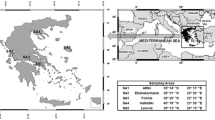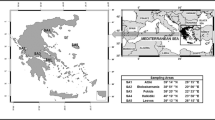Abstract
In this study, two software tools, namely the ERICA Assessment Tool and the RESRAD-BIOTA code, are used for the calculation of the radiological exposure of non-human organisms. For the purposes of the analysis, data retrieved from field studies are used. The site-specific measurements were performed on organisms (mammals—sheep and goats of Bovidae spp.) collected from free-ranged grazing regions in Greece. Plants (grass) of Poaceae spp. and soil samples were also collected from these regions. Natural radionuclides (226Ra, 228Ra, and 228Th) of lithogenic origin and 137Cs, resulted from human activities (Chernobyl and Fukushima nuclear power plant accidents and global fallout), were detected in all samples. The measured activity concentrations were used as input to the two software tools, the ERICA Assessment Tool and the RESRAD-BIOTA code. The results of the simulations provided the external, internal, and total dose rates received by the organisms due to the exposure to the radionuclides. The assessments indicated that out of all detected radionuclides, 228Th is the main contributor to the external dose and 226Ra and 228Ra are the main contributors to the internal dose. The comparative analysis of the two tools revealed significant differences in the calculated doses. In fact, external and internal doses calculated by RESRAD-BIOTA are higher than the values calculated by the ERICA Tool, due to the dose conversion coefficients (DCCs) used for the dose calculation. RESRAD-BIOTA provides more conservative values, but ERICA Tool provides lower uncertainty due to the higher flexibility in the design of the phantom organism. On a risk assessment basis, there is no significant impact, due to organisms’ exposure to radioactivity. However, further consideration of the exposure levels is required due to the potential effects of protracted low-level ionizing radiation on the various levels of life’s organization.







Similar content being viewed by others
References
Aliyu AS, Ramli AT, Garba NN, Saleh MA, Gabdo HT, Liman MS (2015) Fukushima nuclear accident: preliminary assessment of the risks to non-human biota. Radiat Prot Dosim 163(2):238–250
Amiro BD (1997) Radiological dose conversion factors for generic non-human biota used for screening potential ecological impacts. J Environ Radioact 35:37–51
Beresford NA, Balonov M, Beaugelin-Seiller K, Brown J, Copplestone D et al (2008) An international comparison of models and approaches for the estimation of the radiological exposure of non-human biota. Appl Radiat Isot 66:1745–1749
Beresford NA, Barnett CL, Brown JE, Cheng J-J, Copplestone D, Gaschak S, Hosseini A, Howard BJ, Kamboj S, Nedveckaite T, Olyslaegers G, Smith JT, Vives I Batlle J, Vives-Lynch S, Yu C (2010) Predicting the radiation exposure of terrestrial wildlife in the Chernobyl exclusion zone: an international comparison of approaches. J Radiol Prot 30:341–373
Biermans G, Horemans N, Vanhoudt N, Vandenhove H, Saenen E et al (2014) An organ-based approach to dose calculation in the assessment of dose-dependent biological effects of ionising radiation in Arabidopsis thaliana. J Environ Radioact 133:24–30
Brechignac F, Oughton D, Mays C, Barnthouse L, Beasley J, Bonisoli-Alquati A et al (2016) Addressing ecological effects of radiation on populations and ecosystems to improve protection of the environment against radiation: agreed statements from a consensus symposium. J Environ Radioact 158-159:21–29
Copplestone D, Beresford NA, Brown JE, Yankovich T (2013) An international database of radionuclide concentration ratios for wildlife: development and uses. J Environ Radioact 126:288–298
Cujic M, Dragovic S (2018) Assessment of dose rate to terrestrial biota in the area around coal fired power plant applying ERICA tool and RESRAD BIOTA code. J Environ Radioact 188:108–114
ERICA (2007) The ERICA assessment tool: environmental risk from ionizing contaminants: assessment and management. Version 1.3.1.51 - Updated 2019.07.12. Help Function Document. Available from: http://www.erica-tool.eu. Accessed 9 Jun 2019
Florou H, Tsytsugina V, Polikarpov GG, Trabidou G, Gorbenko VV, Chaloulou C (2004) Field observations of the effects of protracted low levels of ionizing radiation on natural aquatic population by using a cytogenetic tool. J Environ Radioact 75:267–283
Florou H, Trabidou G, Nikolaou G (2007) An assessment of the external radiological impact in areas of Greece with elevated natural radioactivity. J Environ Radioact 93:74–83
Higley KA (2010) Estimating transfer parameters in the absence of data. Radiat Environ Biophys 49:645–656
Higley KA, Domotor LS, Antonio EJ, Kocher DC (2003) Derivation of a screening methodology for evaluating radiation dose to aquatic and terrestrial biota. J Environ Radioact 66:14–59
Howard BJ, Beresford NA, Copplestone D, Telleria D, Proehl G, Fesenko S et al (2013) The IAEA handbook of radionuclide transfer to wildlife. J Environ Radioact 121:55–74
IAEA (1989) Measurements of radionuclides in food and the environment: a guidebook. In: Technical Report Series No. 295. International Atomic Energy Agency, Vienna
IAEA (2014) Handbook of parameter values for the prediction of radionuclide transfer to wildlife. Technical Report Series No. 479, International Atomic Energy Agency, Vienna
ICRP (1983) Radionuclide transformations: energy and intensity of emissions. ICRP publication 38. Ann. ICRP, pp. 11-13
ICRP (2003) Relative biological effectiveness, radiation weighting and quality factor, ICRP Publication 92, Ann. ICRP 33 (4)
ICRP (2007) The 2007 recommendations of the international commission on radiological protection, ICRP Publication 103, Ann ICRP 37 (2–4)
ICRP (2008) Environmental protection: Τhe concept and use of reference animals and plants, ICRP Publication 108, Ann ICRP 38 (4–6)
ICRP (2009) Environmental protection: transfer parameters for reference animals and plants, ICRP Publication 114, Ann ICRP 39 (6)
Johansen MP, Twining JR (2010) Radionuclide concentration ratios in Australian terrestrial wildlife and livestock: data compilation and analysis. Radiat Environ Biophys 49:603–611
Johansen MP, Barnett CL, Beresford NA, Brown JE, Cerne M, Howard BJ et al (2012) Assessing doses to terrestrial wildlife at a radioactive waste disposal site: inter-comparison of modelling approaches. Sci Total Environ 427-428:238–246
Johansen MP, Kamboj S, Kuhne WW (2013) Whole-organism concentration ratios for plutonium in wildlife from past US nuclear research data. J Environ Radioact 126:412–419
Kamboj S, LePoire D, Yu C (2002) External exposure model in the RESRAD computer code. Health Phys 82:831–839
Karimullina E, Antonova E, Pozolotina V (2013) Assessing radiation exposure of herbaceous plant species at the East-Ural radioactive trace. J Environ Radioact 124:113–120
Karimullina E, Mikhailovskaya LN, Antonova E, Pozolotina VN (2018) Radionuclide uptake and dose assessment of 14 herbaceous species from the East-Ural radioactive trace area using the ERICA tool. Environ Sci Pollut Res Int 25:13975–13987
Kioupi V, Florou H, Kapsanaki-Gotsi E, Gonou-Zagou Z (2015) Bioaccumulation of the artificial Cs-137 and the natural radionuclides Th-234, Ra-226 and K-40 in the fruit bodies of Basidiomycetes in Greece. Environ Sci Pollut Res Int 23(1):613–624
Klement AW (1982) Handbook of environmental radiation, CRC series in radiation measurement and protection. CRC Press Inc., Boca Raton
Kritidis P, Florou H (2001) Radiological impact in Greece of the Chernobyl accident – a ten year retrospective synopsis. Health Phys 80(5):440–446
Kritidis P, Florou H, Eleftheriadis K, Evangeliou N, Gini M, Sotiropoulou M et al (2012) Radioactive pollution in Athens, Greece due to the Fukushima nuclear accident. J Environ Radioact 114:100–104
Mazeika J, Marciulioniene D, Nedveckaite T, Jefanova O (2016) The assessment of ionising radiation impact on the cooling pond freshwater ecosystem non-human biota from the Ingalina NPP operation beginning to shut down and initial decommissioning. J Environ Radioact 151:28–37
Petrovic J, Dordevic M, Dragovic R, Gajic B, Dragovic S (2018) Assessment of radiation exposure to human and non-human biota due to natural radionuclides in terrestrial environment of Belgrade, the capital of Serbia. Environ Earth Sci 77(290):1–12
Polikarpov GG (1998) Conceptual model of responses of organisms, populations and ecosystems to all possible dose rates of ionizing radiation in the environment. Radiat Prot Dosim 75:181–185
Probonas M, Kritidis P (1993) The exposure of Greek population to natural gamma radiation of terrestrial origin. Radiat Prot Dosim 46(2):123–126
Reinardy HC, Teyssie J-L, Jeffree RA, Copplestone D, Henry TB, Jha AN (2011) Uptake, depuration and radiation dose estimation in zebrafish exposed to radionuclides via aqueous or dietary routes. Sci Total Environ 409:3771–3779
Servitzoglou N, Stoulos S, Katsantonis D, Papageorgiou M, Siountas A (2018) Natural radioactivity studies of phosphate fertilizers applied on Greek farm soils used for wheat cultivation. Radiat Prot Dosim 181(3):190–198
Sotiropoulou M (2017) Radiological modeling in the environment: application and adaptation of ionising radiation dosimetry models in the Mediterranean terrestrial ecosystem. PhD Thesis, Aristotle University of Thessaloniki, Greece (https://www.didaktorika.gr/eadd/handle/10442/42098?locale=en). Accessed 8 Mar 2019
Sotiropoulou M, Florou H, Manolopoulou M (2016) Radioactivity measurements and dose rates calculations using ERICA tool in the terrestrial environment of Greece. Environ Sci Pollut Res 23(11):10872–10882
Sotiropoulou M, Florou H, Kitis G (2017) Calculating the radiological parameters used in non-human biota dose assessment tools using ERICA tool and site-specific data. Radiat Environ Biophys 56:443–451
Taranenko V, Prohl G, Gómez-Ros JM (2004) Absorbed dose rate conversion coefficients for reference terrestrial biota for external photon and internal exposures. J Environ Radioact 24:35–62
Ulanovsky A, Pröhl G, Gómez-Ros JM (2008) Methods for calculating dose conversion coefficients for terrestrial and aquatic biota. J Environ Radioact 99:440–1448
UNSCEAR (2008) United Nations Scientific Committee on the Effects of Atomic Radiation. Sources and effects of Ionising radiation. Report to the general assembly, with scientific annexes. Annex E: effects of ionising radiation on non-human biota. United Nations, New York
USDoE (1997) Environmental measurements laboratory, procedures manual, HASL-EML-300, US Department of Energy, 28th Edition, New York
USDoE (2002) A graded approach for evaluating radiation doses to aquatic and terrestrial biota. US Department of Energy, Washington D.C., Technical Standard DOE-STD-1153-2002
USDoE (2004) RESRAD-BIOTA: a tool for implementing a graded approach to biota dose evaluation. ISCORS Technical Report 2004–02 DOE/EH-0676. United States Department of the Environment, Washington D.C.
Vetikko V, Kostiainen E (2013) Assessment of doses to game animals in Finland. J Environ Radioact 125:69–73
Vives i Batlle J, Jones SR, Gomez-Ros JM (2004) A method for calculation of dose per unit concentration values for aquatic biota. J Radiol Prot 24:13–34
Vives i Battle J, Beaugelin-Seiller K, Beresford NA, Copplestone D, Horyna J, Hosseini A et al (2010) The estimation of absorbed dose rates for non-human biota: an extended intercomparison. Radiat Environ Biophys 50:231–251
Yu C, Cheng J-J, Kamboj S (2013) Effects of the new wildlife transfer factors on RESRAD-BIOTA’s screening Biota Concentration Guides and previous model comparison studies. J Environ Radioact 126:338–351
Zhang X, Yang Z, Qin C (2017) Comparison and applicability analysis of models for estimating radiological dose rates of freshwater biota. IOP Conf Series: Earth and Environmental Science 108:4 Environmental Engineering and Technology
Acknowledgments
Acknowledgments are owed to Mr. Nikolaou Georgios (Assoc. Professor, Democritus University of Thrace) for his contribution to the improvement of this manuscript.
Author information
Authors and Affiliations
Corresponding author
Additional information
Responsible editor: Georg Steinhauser
Publisher’s note
Springer Nature remains neutral with regard to jurisdictional claims in published maps and institutional affiliations.
Rights and permissions
About this article
Cite this article
Sotiropoulou, M., Florou, H. Radiological risk assessment in the terrestrial ecosystem: comparative study of two software tools used for dose rate calculations. Environ Sci Pollut Res 27, 18488–18497 (2020). https://doi.org/10.1007/s11356-020-08186-5
Received:
Accepted:
Published:
Issue Date:
DOI: https://doi.org/10.1007/s11356-020-08186-5




